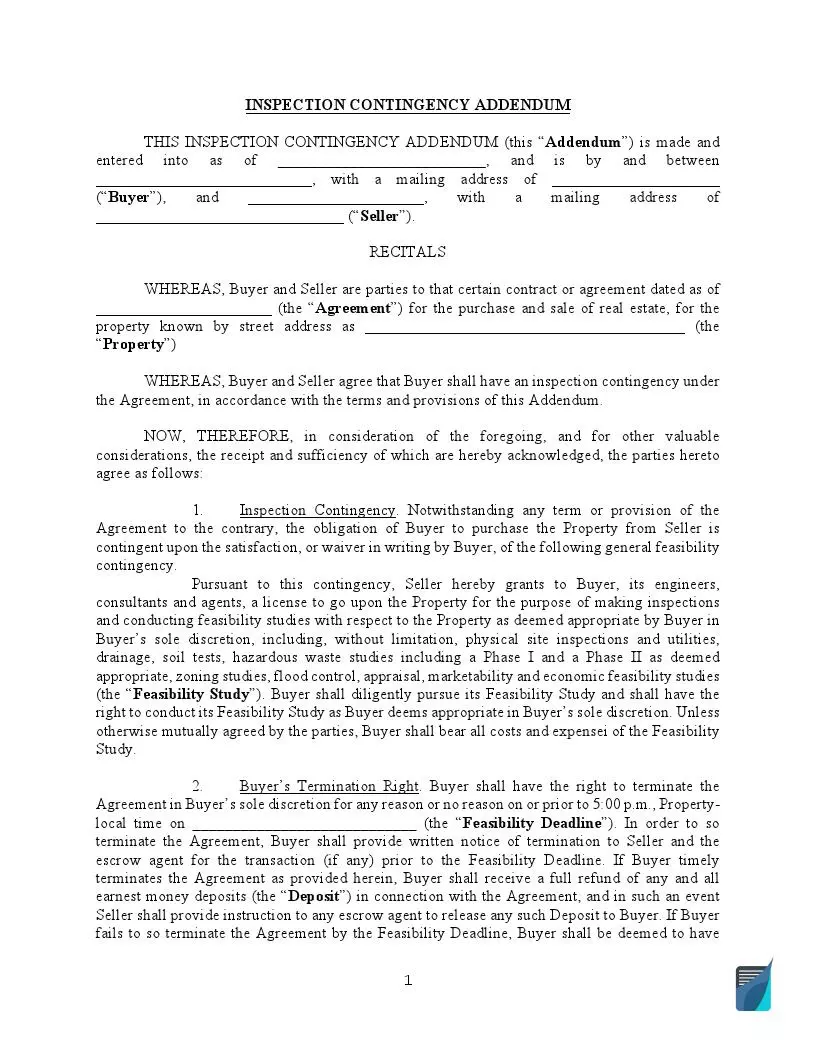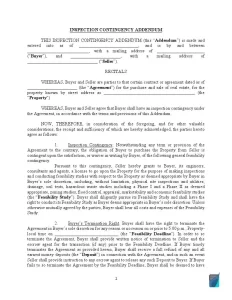Inspection Contingency Addendum Form
If you are purchasing or selling a home, you might need an inspection contingency addendum. It will help you to make sure that your purchase agreement and the property you are buying are in good shape. Use this guide and the template to get started with your inspection contingency addendum.

Build Your Document
Answer a few simple questions to make your document in minutes
Save and Print
Save progress and finish on any device, download and print anytime
Sign and Use
Your valid, lawyer-approved document is ready
What Is a Contingency Addendum?
This addendum to real estate purchase contract allows the buyer of a real estate property to get out of their purchase agreement if they happen to find defects in the property. The buyer will not typically inspect the home themselves. An inspector, electrician, or plumber will perform an inspection and then let the buyer know if everything looks good.
If problems are found, the buyer and seller will need to negotiate and come to new terms about the property. If new terms cannot be met, the buyer can release themselves from the printable real estate sales contract and receive their earnest money deposit back.
The buyer can also waive any objections if the seller chooses not to renegotiate the terms of the transaction. It’s up to the buyer if they want to go ahead with the sale or not.
Why Is It Necessary to Use an Inspection Contingency?
This document will help the buyer know if there are any existing problems within the home or property. It will save them money from having to fix various things in the home they are buying. It will also allow them to know the condition of their property when they buy it.
What Are the Disadvantages of an Inspection Contingency?
The inspection contingency allows buyers to back out of the purchase agreement for a variety of reasons, even small ones. Inspection contingencies can add stress to the seller by not knowing for sure if they will be able to sell their home.
Some people will also be wary of selling to buyers who want strict inspections. They may be less likely to agree to the purchasing terms or choose not to take their home off the market.
What a Home Inspection Covers
A home inspection will cover a basic check of the infrastructure and foundation of the home. Make sure the following interior and exterior items are always checked:
- Wallcoverings
- Landscaping
- Grading
- Elevation
- Drainage
- Driveways
- Fences
- Sidewalks
- Fascia
- Trim
- Doors
- Windows
- Lights
- Exterior receptacles
- Framing
- Ventilation
- Type of roof construction (not the condition)
- Flashing
- Gutters
- Water heaters
- Furnaces
- Air conditioning
- Ductwork
- Chimneys
- Fireplaces
- Sprinklers
A plumbing inspection should include:
- Toilets
- Showers
- Sinks
- Faucets
- Drain and waste system
- Vent pipes
Electrical inspections will include:
- Main panel
- Circuit breakers
- Wiring
- Grounding
- Exhaust fan
- Ceiling fans
- Light fixtures
All home appliances that will be left in the home need to be inspected including the washer and dryer if they are staying.
Garages will also need to be inspected:
- Slab
- Walls
- Ceiling
- Vents
- Entry
- Firewall
- Garage door
- Openers
- Windows
- Roof
- Lights
- Receptacles
What a Home Inspection Cannot Cover
Home inspections vary by state and local guidelines. However, most home inspections do not cover:
- Rodents
- Lead
- Mildew
- Mold
- Other fungi
- Wood-destroying organisms
- Methane
- Radon
- Radiation
- Asbestos
- Formaldehyde
Check with your state’s guidelines. Inspection contingencies can also include hiring a specialist to inspect some of the items on the list above. Keep in mind that home inspectors are not allowed to discuss or decide about inspections that they do not specialize in.
What to Do If the Property Needs to Be Repaired
If you find the property needs to be repaired, you have a few options. First, you will need to decide if you are still willing to live in and buy the home based on the repairs that are needed. For example, some buyers choose not to go ahead with the closing if mold or certain pests are found.
If the seller is paying for the repairs
If the seller agrees to buy for the repair, there are a few options for getting the money. First, the seller can credit you back a portion of the purchase price. This means that you will need to come to an agreement on how much the repairs may cost. Make sure you have a very accurate estimate if you are choosing to go this route.
The money will usually be transferred to you directly or into an escrow account for you to draw on after the closing.
You can also choose to ask the seller to reduce the sale price by the estimated repair cost. Instead of you paying the full price and then getting some of the money back for repairs, you will simply pay the price for the house after repair costs have been deducted.
This is a good option if some of the repairs are flexible and you aren’t in a hurry to pay to get them all done at one time or before the move-in date.
Some people choose to trust the seller to complete the repairs themselves before closing. This isn’t recommended unless the repairs are very simple and not serious. The seller may also try to do the repairs themselves or hire someone to do a very cheap job.
You can also choose to hire someone to do the repairs and just have the seller pay the company directly. Make sure you get a quote of the amount before having someone start any repairs. You will want to make sure the seller is okay with the repair costs and willing to pay them.
If the seller will not pay for repairs
In some cases, the seller will not pay for repairs or is not required to pay for certain repairs. You will need to determine if you are willing to pay for the repairs yourself and if you still want to buy the property.
In this case, you can plan to do the repairs yourself before you move in or afterward. Some lenders will give buyers larger mortgages if they must do repair work to help you pay for the work.

Filling Out the Inspection Contingency Addendum Template
Follow these tips for ensuring that the template is filled out correctly.
Indicate the parties
Write down all the information from the buyer and seller. Include full names and mailing addresses.
Indicate the property
Write down the date of the original purchase agreement and the address of the property that is being sold.
Indicate the inspection closing date
Indicate the date that buyer has to terminate the purchase agreement. They will need to decide to move forward or to back on by the date listed in this section.
Signatures
The buyer and seller will need to provide their signatures and printed names.